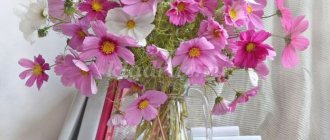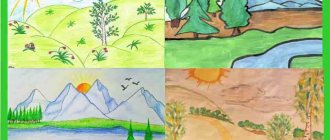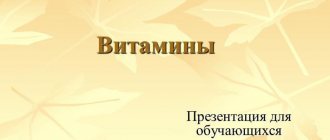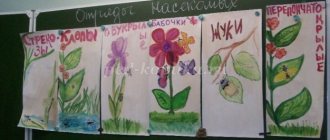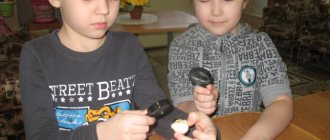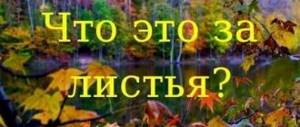Lesson about the world around us, 1st grade. What's growing on the windowsill? School of Russia
Lesson summary on the surrounding world in 1st grade on the topic “What grows on the windowsill?” UMK A. A. Pleshakova (“School of Russia”)
Objectives : introduce the most common indoor plants; teach to recognize houseplants in the classroom. Planned results : students will learn to recognize indoor plants from drawings and with the help of an atlas-identifier; observe the school's indoor plants. Equipment : task cards, indoor plants, school dictionary “Plants of Russia”;
Students have colored pencils and colorful chips. Lesson progress
I. Organizational moment II. Updating knowledge 1. Work with cards 1. Indicate with an arrow which part of each plant the person uses. 2. Color the roots brown and the fruits yellow (fill in the circle).
2. Graphic dictation (The work is done on checkered pieces of paper, which are signed by the teacher. The teacher reads the statements, the students put the appropriate sign (the signs are given on the board).) • Shrubs have one stem. (No.) • In lettuce, people use the leaves for food. Yes.) • Raspberries and currants are shrubs. (Yes.) • In potatoes, people use the fruit with seeds for food. (No.) • The fruit with seeds is the above-ground part of plants. Yes.) • Cabbage is a root vegetable. (No.) • Nettle and dandelion leaves can be used as food. Yes.) • All plants have roots. Yes.) • Plants are part of living nature. Yes.) — What plants of Russia did you learn about from the school dictionary? (Children's answers.) (You can use CMMs (test 4, p. 9).) III. Self-determination for activity - Ant is again in a hurry to ask you riddles. Guess them. White basket, Golden bottom. There is a dewdrop in it and the sun sparkles. (Chamomile.) - Hey, bells - Blue color - With a tongue, But no bells! (Bell.) The face is fragrant, and the tail is prickly. (Rose.) - Which group can these plants belong to? (These are flowers.) - Where did you see daisy and bell? (In the meadow.) - Where do roses grow? (In the garden, in the flower beds.) - Where else do people grow flowers? At home.) - What are the names of the flowers that are grown at home? (Room.) - Who guessed what we will talk about in class today? (About indoor flowers.) - Read the topic of the lesson on p. 24 textbooks. (What grows on the windowsill?) - Our Ant will help us get to know each other better with the educational task of the lesson. Read what we will learn today, what we will learn. IV. Work on the topic of the lesson - Ant Question asks to look at the flowers on the windowsills in our class. Are there plants among them that are familiar to you? What are their names? (Children's answers.) (On the windowsills of the class there are various indoor plants: sansevieria (pike tail), calla lilies, hippeastrum, cacti, violets, begonias, etc. The teacher invites students from the first row to approach the first window sill, from the second row to the second, from the third row - to the third.) - Carefully touch the leaves of the plants, carefully examine the color of the flowers. — Which of you met familiar plants? What are their names? (Children's answers.) - Look at the pictures on p. 24 textbooks. What can you say? (The pictures show plants that grow on windowsills.) - Look carefully at each plant. Mark with a green counter the flowers that we have in our class. - What are the names of the plants that you could not name? (The teacher shows the plant, and the students read the names of the plants from the textbook and find the corresponding plant in the class.) - Look at the leaves of the begonia. Their color can be very diverse. Plant height is from 15 cm to 2 m. Low-growing begonias are grown on window sills. The homeland of begonia is the humid forests of hot countries. — What does a cactus remind you of? Who does he look like? (Like a hedgehog.) Indeed, the cactus is often called a green hedgehog. The homeland of this plant is distant deserts. - Now read the name of this plant. (The teacher points to the sansevieria.) - Say this difficult name in chorus. Popularly, this plant is often called “pike tail”. Why do you think? (Children’s answers.) - What plant’s name do you think means “gentleman with a star”? (Children's answers.) - Why? How do you explain this? (Children's answers.) - Let's say the name of the plant in unison. (Hippeastrum.) - Guess what kind of plant we are talking about: it has large leaves, flowers look like boats. (Calla.) - And this plant pleases the eye with many modest beautiful flowers. (Violet.) - Which of the plants shown in the picture do you have at home? Mark them with a blue chip. V. Physical education minute The flower was sleeping and suddenly woke up - (Tilts the body to the right and left.) He didn’t want to sleep anymore. (Tilts the torso forward and backward.) He moved, stretched, (Hands up, stretch.) Soared up and flew. (Hands up, left, right.) The sun just wakes up in the morning, the butterfly circles and curls. (Spin around.) - Why is a butterfly compared to a flower? (She is just as beautiful, bright, colorful, tender.) VI. Continuation of work on the topic of lesson 1. Practical work in pairs - Guys, there are still plants in our class whose names we don’t know. How can you find out their names using an atlas-identifier? (Children's answers.) (Using the atlas, students determine the names of one or two more plants in the class. Then they complete the task in the workbook (p. 13, No. 1) and report the results of their work.) 2. Work from the textbook - Look to the Wise Turtle on p. 25. What an interesting outfit she has! Who does she look like? (For a traveler.) - Do you know that our plants are also travelers? They came to us from different places. Who remembers where the homeland of cacti is? (In the desert.) It is very hot in the desert, and that is why the cactus has spines instead of leaves. — Look at the photographs on p. 25. Determine the homeland of cacti and begonias from photographs. Prove the correctness of your choice to your desk neighbor. (Check.) 3. Completing tasks in workbook No. 2 (p. 14).
— Look at the fragments of plants.
What plants could you recognize? By what signs? - Complete the task. (Textbook check (p. 24).) No. 3 (p. 14).
— Name your favorite indoor plant.
- Complete the task. — Write a story about your favorite indoor plant. VII. Reflection (Students answer questions in the textbook (p. 25, in the box).) - Evaluate your achievements in the lesson. (Students take out one of the signs and explain their choice.) VIII. Summing up the lesson Indoor flowers make us happy. With them the room becomes beautiful and cozy. Having settled in our home, they bring great benefits: they promote sound absorption, humidify the air, saturate it with oxygen, and cleanse it of harmful impurities. We need to know how to care for them, and then they will delight us with their greenery and beauty for a long time. — The Question Ant asks whether we have completed the learning task of the lesson. What will we answer him? Did we find out the names of indoor plants? Which ones? (Children's answers.) Well done! The ant really liked the way you answered. Recommendations for studying at home 1. Workbook: No. 4 (p. 14).
2. Talk about one of the indoor plants that you have at home. 3. Together with adults, read in the school dictionary “Plants of Russia” about some indoor plant. Additional material
Begonia Herbaceous plant with a height of 15 cm to 2 m. The shape, color and size of the leaves are very diverse. Most begonias bloom at home, but only the tuberous begonia has truly beautiful flowers. Plants of this genus require moderate watering and are afraid of direct sunlight through glass. Begonias reproduce by dividing the rhizomes, as well as by leaf cuttings. Hippeastrum Herbaceous deciduous bulbous plant up to 60 cm high. Hippeastrum is valued for its flowering. In March-April, even before the leaves bloom, a peduncle appears from the bulb, on which 3-4 large “gramophone” flowers of various colors open in turn. After flowering, leaves develop and fall in September-October. For the winter, the pot with the bulb is removed to a dark, cool place and stored there until March-April. Propagated by seeds and babies. Sansevieria is a herbaceous plant of dry habitats, capable of storing water reserves in succulent leaves. Plant height is from 15 cm to 1 m, depending on the type. One of the most common indoor plants, often called "pike tail". Sansevierias vary in shape - from small rosettes with short pointed leaves to tall narrow-leaved forms. Very varied in color. Sansevierias bloom - an inflorescence up to 30 cm high with small white flowers that exude an unusual aroma. Drops of sweet nectar form under each flower to attract insects. Sansevierias are very light-loving and grow poorly in low light; they do not tolerate excess moisture at all. It is recommended to completely dry the substrate in the pot where sansevieria grows, and only then water it. They reproduce by daughter rosettes. Uzambara violet (Saintpaulia) Violet is a symbol of the awakening of nature. The violet represents innocence, purity and modesty. This flower is held in high esteem by the French. Among indoor plants, violet (Saintpaulia) occupies a special place. A huge variety of varieties, lush and long flowering, ease of cultivation and propagation - all this makes it a favorite house plant. The story of the transformation of modest Cinderella into a princess began in 1893. Shortly before this, Baron Walter von Saint-Paul found an interesting plant in the forests of East Africa, at the foot of the Uzambara Mountains. Pale blue flowers with bright yellow anthers reminded the traveler of forest violets growing in his native Belgium. He collected the seeds and sent them to Europe to his father. The famous botanist Hermann Wendland described the plant as a new genus and named it Saintpaulia, in honor of the discoverer and his father. With all the variety of violets, the first place is occupied by large-flowered exhibition varieties. The flowers of these plants are amazing - they are huge, up to 7 cm in diameter. The shape of the flower can be double, semi-double, or not double. The petals, in turn, are wavy, folded, as if ironed, with frilly or lace edges. It is interesting to observe how, with increasing daylight hours, buds begin to form in February, and mass flowering occurs from March to May. From late August to November there is a second wave of flowering. Winter is a short rest for window plants, but with artificial light they bloom all year round. Cacti The homeland of cacti is America. Cacti grow very slowly. Thanks to their varied shape, pubescence, color, beautiful flowers, and bright fruits, they have gained great popularity. Cacti are grown in bright, dry, well-ventilated areas. In summer they water rarely, but abundantly, in winter - even less often. Cacti reproduce by seeds, stem and root cuttings, suckers and grafting. Calla, or calla lily, is native to South Africa. A herbaceous plant with a tuberous rhizome and a rosette of arrow-shaped leaves on long cuttings. Numerous small flowers without a perianth are collected in an inflorescence - a spadix, surrounded by a white sheath. The plant is shade-tolerant. Abundant watering and frequent spraying are necessary, especially during the flowering period. In winter, water moderately and keep in a cool room. Propagated by suckers formed on the pineal rhizome. Monstera, ficus The leaves of monstera and ficus are capable of trapping dust particles on their surface. The larger the leaf surface, the better. Therefore, the leaves of these plants should be wiped more often with a damp cloth. The presence of monstera and ficus in the room helps to enrich the air with ions, which has a very beneficial effect on human health. Tradescantia is a perennial herbaceous plant with creeping stems. It got its name in honor of the English gardener John Tradescant. There are many forms and varieties with different leaf colors. Author: Maksimova T. N.
We recommend watching:
Lesson summary of the surrounding world in 1st grade Extracurricular lesson on the surrounding world. Notes for 1st grade Lesson of the surrounding world, 1st grade. What do different plants have in common? School of Russia Lesson of the surrounding world, 1st grade. What's growing in the flowerbed? School of Russia
Similar articles:
Excursion “What do we know about the rules of the road?”, 1st grade
Lesson about the world around us in 1st grade. Where do snow and ice come from?
Lesson notes on the world around us, 1st grade. How to help birds in winter. Pleshakov
Lesson about the world around us, 1st grade. When is it interesting to study? School of Russia
Lesson about the world around us, 1st grade. Where do polar bears live? School of Russia
- What grows on the windowsill - September 2020. Review No. 3 ⌚ - 10 minutes 59 seconds
- What grows on the windowsill. Indoor flowers. ⌚ — 5 minutes 35 seconds
- The world around us, grade 1, part 1, lesson topic \ ⌚ — 28 seconds
- The world around us, grade 1, part 1, lesson topic \ ⌚ — 39 seconds
- What's growing in our flowerbed?/ Super review of new things! ⌚ — 5 minutes 58 seconds
- Handicrafts and plant growing - video tutorials. What grows on the windowsill. Review #2 ⌚ – 12 minutes 21 seconds
- MAGIC BEACON What grows in the flowerbed 1130 edition 2020 ⌚ — 15 minutes 1 second
- What's growing on my windowsill?
